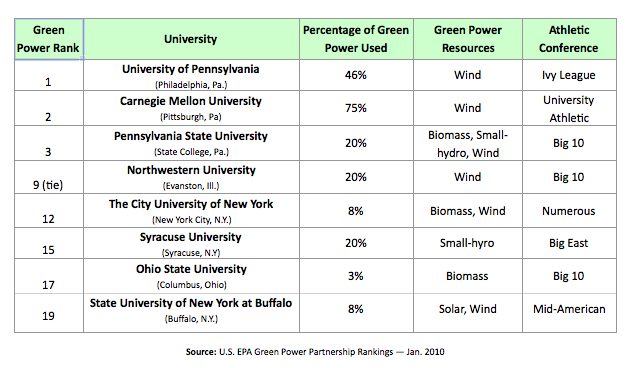
Even though Carnegie Melon used more green power last year, the University of Pennsylvania tops the list because it also bought renewable certificates that offset electricity use. Click to enlarge.
The Ohio State University Buckeyes hammered Penn State’s Nittany Lions last year in their regular season matchup. Ohio State players scored more touchdowns, gained more yards and limited their rival to a season-low seven average.
The Nittany Lions made up for the loss on a different playing field.
Pennsylvania State University earned the number three spot on the United States Environmental Protection Agency’s top green power purchasers list; Ohio State barely ranked at 17.
The EPA compiles the quarterly top 20 lists to spur competition among schools and companies that purchase wind, solar, biomass and low-impact hydroelectric power.
Rankings reflect a combination of energy conservation efforts. The organization that uses or purchases the most green power earns the top spot.
The EPA even taps into athletic rivalries to encourage the use of renewable energy. One of lists pits university athletic conferences against each other in a Green Power Challenge.
“The whole point is to encourage competition within certain sectors,” said Allison Dennis, communications manager for EPA’s Green Power Partnership.
The Big 10 Conference came in third place in the challenge last year. The conference upped its combined green power use by 12 percent this year and now holds the number two spot.
Nearly half of the universities on the agency’s top green power purchasers list are located in the Great Lakes region. Universities must partner with the EPA to be ranked.
Partners voluntarily commit to green power for a certain percentage of their energy needs, Dennis said.
“The largest source of our carbon emissions is associated with electricity use,” she said. “Green power is one way every person and organization can green their operation.”
To meet commitments, partners either produce their own renewable energy or get it elsewhere.
When local green power sources aren’t available, partners can buy renewable energy certificates, or green tags. A certificate proves that one megawatt-hour of electricity was generated from a green power source, according to the EPA.
Universities purchase certificates to offset electricity use from nonrenewable energy sources. Approximately 75 percent of the program is based on purchase of certificates, Dennis said.
Green tags help in terms of overall energy conservation, said John Russo, utility manager at the State University of New York at Buffalo.
The EPA ranks universities based on how much green power is purchased through certificates and how much is actually used.
The University of Pennsylvania gets 30 percent of its energy needs from wind-generated power, according to the EPA. It also purchases the most green tags, which is why it earned the top spot.
“New York University overtook us for six months, but we came out on top again,” said Julie McWilliams, the university’s communications representative.
The university is part of the Ivy League conference, which has won the Green Power Challenge for athletic conferences every year since its creation in 2006.
Three Big 10 universities are on the EPA’s top purchasers list.
Northwestern University has tied for ninth the past two years. Ohio State University wasn’t on the list in Jan. 2009, but came in 17th place this year.
The State University of New York at Buffalo moved up a spot from last year. The university is the largest purchaser of wind power of any New York State Agency, according to the EPA. The campus gets 20 percent of its energy from wind and solar sources.
The University at Buffalo invested in renewable energy approximately five years ago, Russo said.
“It was a way to meet requirements of the state,” he said.
In 2002, New York Gov. George Pataki signed an executive order that encouraged the use of renewable energy, Russo said. In his Green and Clean campaign, Pataki defined green standards and design practices for government buildings and vehicles.
Many New York state agencies, including the University at Buffalo, stepped up to the plate. The amount of energy generated from renewable sources in New York doubled from 2005 to 2006, according to a report by the National Renewable Energy Laboratory.
The same report shows demand for green power in Great Lakes states has steadily increased since 2004. Six years ago, Midwesterners demanded approximately 160 billion hours of energy from green sources, the report estimated.
By 2012, the National Renewable Energy Laboratory expects demand to exceed a trillion watt hours, according to the report.
But demand is limited by supply. And there’s not a lot of supply out there, Russo said.
Green power plants still need to sell electricity to make money, he said. Selling renewable energy certificates helps, but the price of energy is down.
“I think that’s going to keep a lot of developers from developing new projects for at least a year or two,” Russo said.
Budget cuts also mean there’s less money to spend on expensive certificates.
“Everyone wants them, but their budgets are going down,” he said. “It’s really going to make it difficult to move forward.”


Green technology tends to save more money in the long run, dteipse being more expensive to begin with for example, motion-sensing light fixtures that only turn on when someone walks into a room are more expensive than regular lights, but after a few years the reduced power usage saves money. What examples of green energy are you looking at that are so cost-inefficient? Around here (Midwest) people have been installing windmills, which are quite green that have consistently proven profitable.
Pingback: Vegetable Gardening : How to Grow Green Peppers
Pingback: Green gardening guide – part one